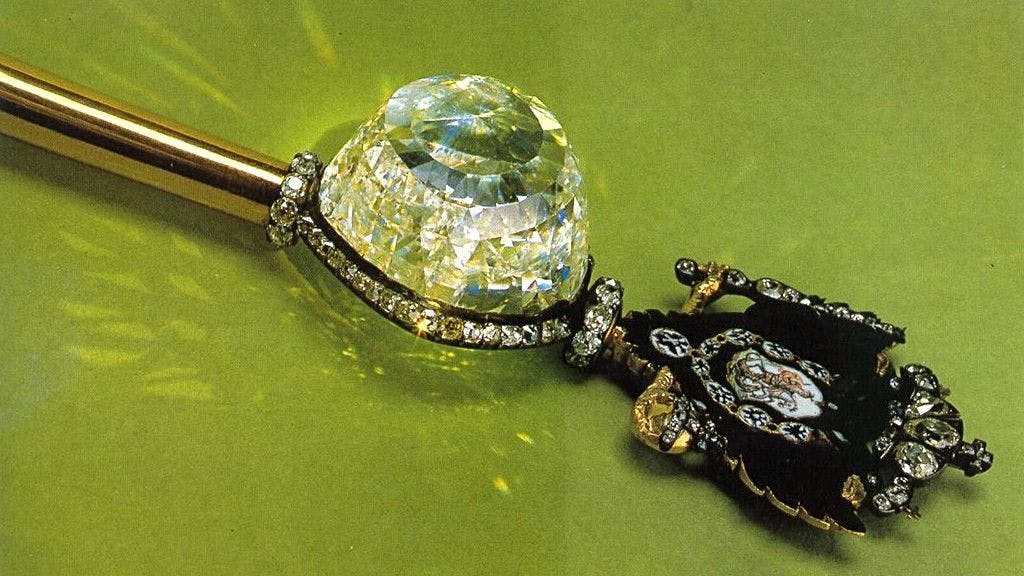Orlov Diamond: To Russia with Love
BOOKMARK
A large number of Indians queue up at the Tower of London to see the Kohinoor diamond, which is a part of the British crown jewels. But in Moscow, Russia there is an even larger Indian diamond, also part of the crown jewels, which few people know of. The Orlov diamond, which was given to Catherine the Great, of Russia, by her lover Count Grigory Orlov in 1772 CE. It forms a part of the Russian crown jewels and is set in the Imperial Sceptre, used by Emperors of Russia till the Russian Revolution in 1918. A sceptre is an ornamental staff or wand, held by ruling monarchs in their hand as a symbol of authority.
The 189.62 carat Orlov Diamond is a Golconda diamond mined at the famed Golconda diamond mines in the Godavari delta. But we still don’t know the real story of how the diamond left Golconda and made its way to Russia.
According to one popular story, the Orlov diamond was one of the two diamonds set as the eyes in a giant statue of Brahma, in the temple of Sri Ranganathaswamy at Srirangam in the Tiruchirapalli district of Tamil Nadu in the 17th century CE.
– The 189.62 carat Orlov Diamond is a Golconda diamond
It is said that one stormy night, a French adventurer, broke into the temple, stole the diamond and then escaped to Madras (Chennai), where he sold it to an English captain for £2,000. The captain then took this stone to Europe and so the diamond left India. But this story, colourful as it sounds, has no evidence to back it. There is no historical record of any such statue existing at the temple in Srirangam. In all probability, this was an exotic tale spun by a European jeweller to get a good price for the diamond.
A more plausible story and one many historians refer to, is that the Orlov diamond is a smaller piece of what was a much larger ‘Great Mughal’ diamond. Jean Baptiste Tavernier, a 17th-century French gem merchant who travelled extensively across India has written about a massive 787-carat diamond that he saw in the Mughal treasury, which he called ‘The Great Mogul diamond’. Tavernier goes on to write that this great diamond was presented to Shah Jahan by Mir Jumla, the diamond merchant turned Prime Minister of Golconda, who had defected to the Mughals. In 1656 CE, when Mir Jumla was called for an audience with Shah Jahan, he is said to have presented him with several famous diamonds including the Kohinoor and this massive ‘Great Mogul’ diamond!
– The Orlov diamond was given to Catherine the Great, of Russia, by her lover Count Grigory Orlov in 1772 CE
Tavernier adds that Shah Jahan had this massive rough stone re-cut by a Venetian lapidary (diamond cutter) named Ortensio Borgio who was present in Delhi at the time. Borgio did such a shoddy job that Shah Jahan confiscated all his money and expelled him from his Empire. At this time, the stone was around 280 carats. The diamond remained in the Mughal Treasury till the sacking of Delhi by Persian invader Nadir Shah in 1739 CE when most of the diamonds and jewels from the Mughal Imperial Treasury were taken to Persia. When Nadir Shah was assassinated in 1747 CE, his possessions were looted and this diamond fell into the hands of an Afghan soldier, who took it with him to Basra, in present-day Iraq. Here, he sold it to an Armenian diamond merchant named Grigori Safras. During that time, the gem trade across the courts of Asia was controlled by Armenians, who had settled in places like Agra, Isfahan and Istanbul.
Catherine the Great (1729-1796 CE) was the Empress of Russia at the time. Her court jeweller, also an Armenian, I.L. Lazarev, came to know of Safras' diamond, but the price demanded was too high. The Empress would not agree. But she was destined to have this diamond. Count Grigorievich Orlov (1723-83 CE) a Russian nobleman and more importantly, Catherine’s lover, bought the diamond for around 4,00,000 roubles and presented it to his beloved in 1772 CE.
Catherine was quite charmed by the gift and it is said that she gifted Count Orlov a large palace in return.
Thus, the ‘Great Mughal Diamond’ got rechristened as the ‘Orlov Diamond’. It was set in the sceptre of the Russian Emperors in 1784 CE. After the Russian Revolution, this diamond became part of the jewels in the Soviet Diamond Fund (now Russian).
The Orlov Diamond is now in the heart of Moscow, behind the high walls of the Kremlin. Few know of its Indian roots or the long-distance it has travelled, to get there!
Cover Image: Elkan Wijnberg










